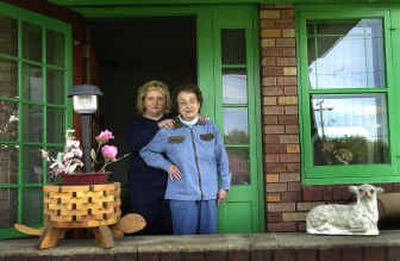Family remains despite changes

The invisible woman of Sprague Avenue pulled her back door partially open, and peered with suspicion through the screen, seemingly surprised she’d been noticed.
No one notices the invisible woman, not the kids on bicycles cutting through her lawn, not the myriad motorists ruffling her hedges with their mechanized wind, not the patrons of the restaurants and you-finish furniture stores surrounding her.
But there she is, standing in her doorway cradling a cordless phone and talking with her daughter next door, whom she encouraged to stay on the line in case anything went wrong.
“Who are you?” she said to the visitor on her steps, her voice hardening and buckling like the six-lane street outside her home between Bowdish and University. “And what do you want?”
Want? As if discovering a woman living beside a road considered too harsh even for knapweed by some wasn’t enough? The rolling roar of asphalt and tires never lets up, not to mention the neighbors and their rock-bottom, blowout prices.
But Rose Chesurin, 81, who has spent all but 11 years of her life on Sprague’s southern edge, doesn’t see the strip that way. “You want to see what it used to be like,” she said, “you should see the movie.”
The “movie” is mile-long celluloid ribbon documenting the best years of Chesurin’s life. Her daughters Mimi and Phyllis star in the production, which uses 1950s Sprague Avenue as a backdrop.
Her husband Gilio, or G, did the filming. To see the footage today, some 50 years after its shooting, is to see G’s family as he did with his right eye pressed against the viewfinder. G died seven years ago.
Even in monochrome, old Sprague Avenue outshines the new one. There’s a road barely two lanes wide running in front of the Chesurin home as kids roll down the driveway on tricycles.
You can count to 20 before a car rolls by. Mimi and Phyllis are girls playing in the ebb of a suburb’s low tide. They are surrounded by empty land with a future as bright as spring grass. They smile like the Andersons of “Father Knows Best,” except warmer, broader than anything Bud or Kitten could muster.
This Sprague, the backdrop for Mimi and Phyllis’ childhood, was America’s through street from Seattle to Minneapolis, U.S. Highway 10.
Chesurin still calls Sprague “the highway.” Her parents, Tony and Philomena Close, gravitated here in the 1920s to start a motel on the avenue, which was then dirt for 1,650 miles. Her father, an ambitious man who spoke six languages, named the motel Casa Loma, the house on the hill.
It is a one story, horseshoe- shaped building with a Shell station on the end of one leg and a produce market on the other. The family was so proud of that building, Chesurin said, it was featured on free postcards handed out to guests.
And the Closes’ children built their homes just a short walk behind their parents, the younger generation helping out the old. The family still lives that way today.
“We had a tavern. My brother had a tavern, Carl’s Tavern in Dishman, where we used to sell Coneys and beer,” Chesurin said. “And we had an auction house in Dishman, and a car lot. Mimi was an auctioneer, just 9 years old. She was the best auctioneer you’d ever seen.”
But the ‘50s ended and so did the film. The Chesurins overturned their family car on a trip to Libby, Mont., and Mimi died in the accident. Rose Chesurin’s mother died just two weeks later and the family’s Golden Age on Sprague just disappeared.
And the invisible woman, who recognizes the shadows of a beautiful Sprague Avenue life no one else sees, receded into the thicket of backlit signs and discount stores going up around her.